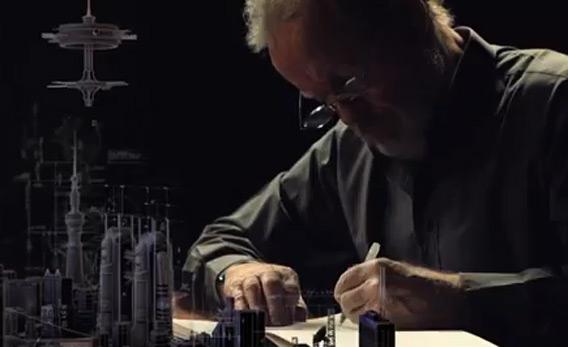Science fiction’s reputation for appealing to the nerdy and anti-social has long suggested that it has more to do with escapism than the real world.
Yet as Ridley Scott’s new Discovery Science show, Prophets of Science Fiction, chronicles, the genre deserves to be taken seriously for its ability to tease out the ethical and moral issues that accompany technological progress. Upon first hearing about Prophets, I expected the director of Alien and Blade Runner to get completely lost in space while discussing Mary Shelley, H.G. Wells, and Philip K. Dick and how their work “foreshadowed” current technologies. Despite the name (we’ll get to that later), I am happy to report that Scott delivered this concept just as efficiently as he delivered that alien baby to the screen: The show successfully brings science fiction and fact into conversation with one another. The first two episodes, for instance, pair Mary Shelley’s Frankenstein and Philip K. Dick’s entire paranoid oeuvre with J. Craig Venter’s creation of synthetic life, plus several other areas of cutting-edge science in which humans are erasing the ground rules of life, death, and reality.
The show could have gotten lost in the asteroid fields of plot and the finer points of the fake science in Shelley’s and Dick’s novels—it could have been a fan show or another simpering documentary. But instead, it successfully ties science fiction icons to the questions that haunted us 200 years ago and now alike, about what it means to be human, about whether there are places that science shouldn’t venture. But it does fall into one easy trap: portraying these fiction writers as “prophets” in the first place.
This is odd because the show pays a lot of attention to historical context and the fact that these ideas were usually circulating in popular culture before getting adapted for far-out fiction. The first episode links Shelley’s fiction to the research of her late-18th-century contemporary, Italian scientist Luigi Galvani, who identified the power of electrical impulses to stimulate muscle action in the corpses of frogs. From there, the show’s narrative shifts to a lab at UCLA, where researchers are using weak electrical stimulation on a man’s lower spinal cord in the hopes of helping him walk again. It’s a startling comparison between Dr. Frankenstein’s twitching monster and the trembling limbs of this paraplegic, whose body can suddenly communicate with its lower half. We watch his face as his own surges back to life.
Seeing the patient look down at this tentative miracle, the show reminds us how deeply hope and loss are connected. Frequently, this tension drives discovery. Despite the mask of objectivity, science springs from human motivations, dreams, and fears that manifest as burning curiosity or a desire to fix what is broken. Shelley’s Frankenstein is a monument to her own mother, who died giving birth to her, as well as her own still-born daughter.
Happily, the show doesn’t shy away from the darker side of contemporary research in celebrating its science fiction seers. One of the world’s many unfortunate lab rats goes graphically under the knife at UCLA to have electrodes embedded in its spinal column. A later segment on Shelley describes the work of IBM researchers in the wonderfully titled field of biometaphorical computing, which is starting down the road to artificial intelligence by emulating the neocortex in a rat’s brain. The glittering lights of the supercomputer contrast with a view of 12 probes jammed into another unlucky rat’s neurons. Galvani’s frog experiments might have looked creepy, but at least the frogs were dead: Scott seems to be reminding us of what Shelley and her romantic circle knew well, that science and art are both born of sacrifice.
In the episode about Philip K. Dick, Scott successfully marries the darkness and ambiguities of Dick’s work to real life, pointing out how none of us seem to care that our future holds constant surveillance and virtual simulations so unhealthy and addictive that people die using them. As Dick knew well, technology is rapidly shifting the ground rules of how we determine reality, a point nicely (if, I think, unintentionally) exemplified by the fact that the Philip K. Dick android was far more plausible than the fake-bearded actor in Prophets of Science Fiction’s 1970s biography scenes.
Dick’s rather biblical portrayal in these flashbacks leads us back to the one real problem I have with the show: the title. “Prophets” tell us what’s to come, sure, but they also imply that scientific discovery is a one-lane road without alternatives. What’s worse, prophets are religious figures, priests who can see the next inevitable revelation before the rest of us. This is terribly misleading because it implies that scientific discovery operates on a smooth rail from fire to fusion reactors—that the “prophets” predict our inevitable fate.
But of course there is no one way it all has to turn out, and one of science fiction’s most important functions is contemplating the monorail not taken. As science fiction author Robert Sawyer has argued in Slate, the “real meaning of research” that science fiction helps us explore is about divergence: best-, worst- and craziest-case scenarios that model the complexity and unpredictability of the real world. And once we get past the slick CGI credits, that is what Prophets of Science Fiction does. Scott reveals the messiness, struggle, and improvisation involved in creating the future in your head or in the lab. When we take science fiction seriously, we realize that we’re not talking about prophecy but another kind of experiment, and it it’s up to all of us to judge the results.
This article arises from Future Tense, a collaboration among Arizona State University, the New America Foundation, and Slate. Future Tense explores the ways emerging technologies affect society, policy, and culture. To read more, visit the Future Tense blog and the Future Tense home page. You can also follow Future Tense on Twitter.
